By nature, Releve’ wants to sit, flexing her hind joints like a star dressage horse. She sits getting out of the trailer. Her first time at a nearby lake, she sat like a reining horse when a boat was crossing the water toward her. And at the Adequan/USDF FEI-Level Trainers Conference West on March 14-15, the mare sat in an eye-popping piaffe that had the auditing judges and the conference presenters saying things like “good grief” and “wow.”
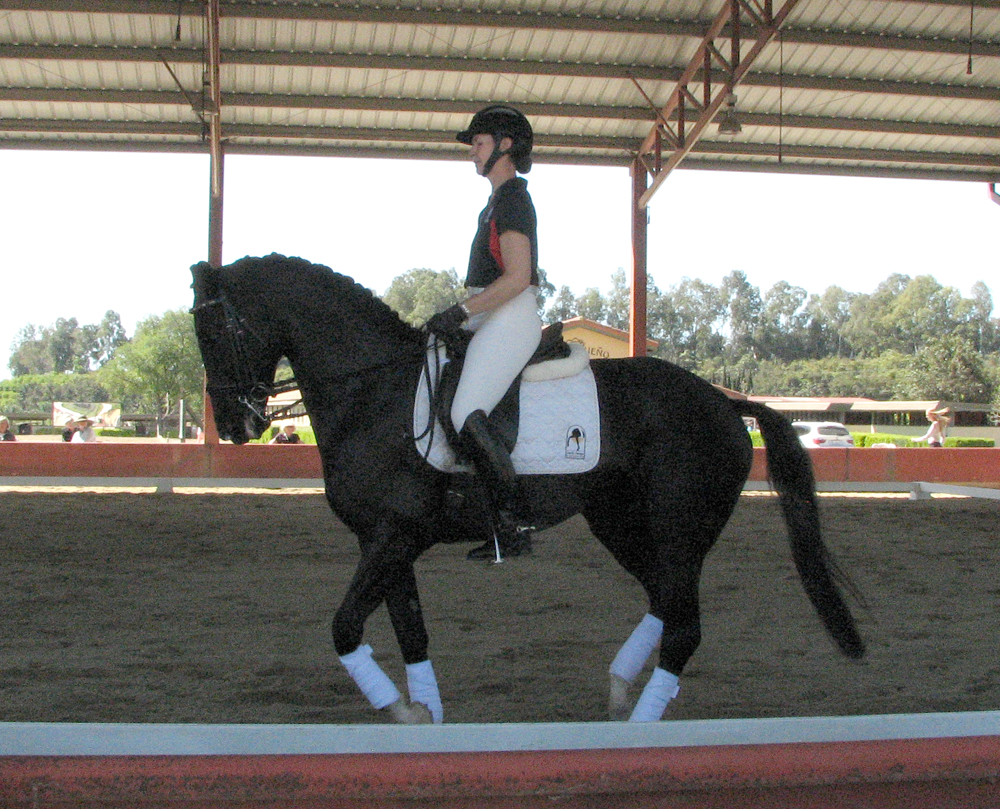
Releve’ and Sandy Savage impressed onlookers with their collected work. Photo by Patti Schofler
The 12-year-old Hanoverian mare by Rotspon and her owner Sandy Savage of Sacramento, Calif., were among eight demonstration riders and horses at the trainers conference, held at El Sueno Equestrian Center in Somis, Calif. More than 160 auditors attended to expand their understanding of dressage with FEI Dressage Judge General Stephen Clarke, who was joined by FEI five-star judge Lilo Fore.
“Stephen and Lilo are so good at explaining what they see. They have so much knowledge,” said Grand Prix rider Jan Ebeling of Moorpark, Calif., who was one of the riders and a panelist during the event Q&A sessions. “They are so good with basics. And if the basics aren’t there, good luck with going forward.”
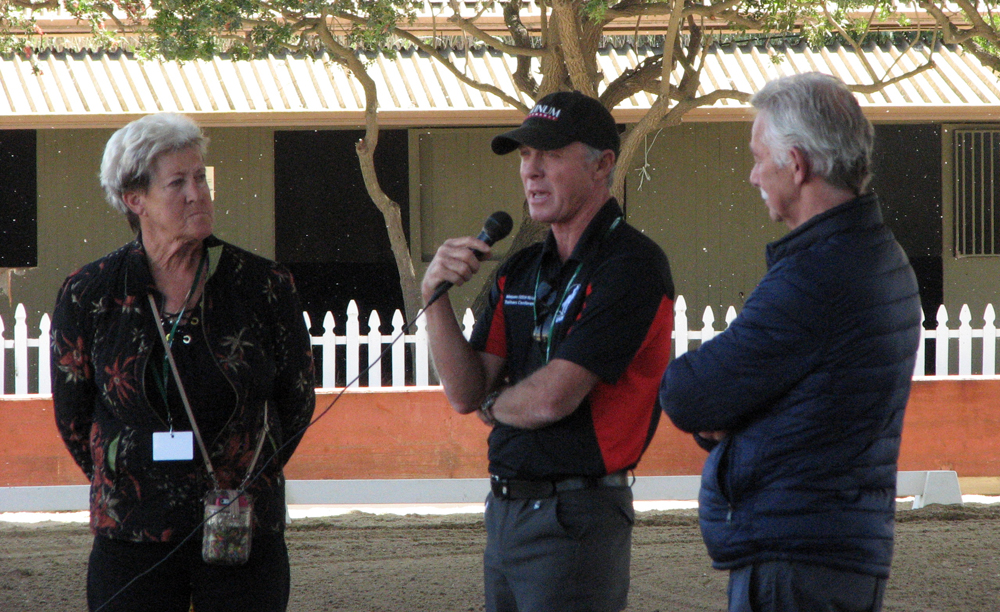
Grand Prix rider Jan Ebeling (center) joined judges Lilo Fore (left) and Stephen Clarke for a question-and-answer session. Photo by Patti Schofler
Ebeling rode two Hanoverian stallions: the 11-year-old Breitan by Breitling and owned by Rob Rom, LLC, and the 13-year-old Rassolini by Rubioso, owned by a syndicate of 10 owners. Other pairs included D’Re Stergios on her 9-year-old mare Sarumba by Sir Donnerhall, Charlotte Bredahl-Baker on her own 6-year-old gelding Hamilton by Glock’s Romaniv, and Sabine Schut-Kery on Alice Womble-Heitmann’s 10-year-old stallion Sanceo by San Remo and Rhea Scott’s 12-year-old PRE stallion Marques.
As he did with the three lower-level horses featured yesterday, Clarke was looking for instant reactions to the aids by the upper-level horses. The responsiveness of Releve’ captured his attention.
“I got her when she was 7, after she had a foal and was started late. She is lovely inside and out. She is on the hotter side but very trusting,” Savage said. “I wanted to see how we measure up, as we are moving up to Prix St. Georges this year.”
After Savage and Releve’ performed a fourth level test, the two judges concluded that the mare needed a bit more strength and a secure feeling so that she could go forward uphill, through her shoulders. Clarke suggested Savage keep a picture in her mind of a horse more uphill with the poll up and the nose line ahead of her, especially to create more expressive flying changes.
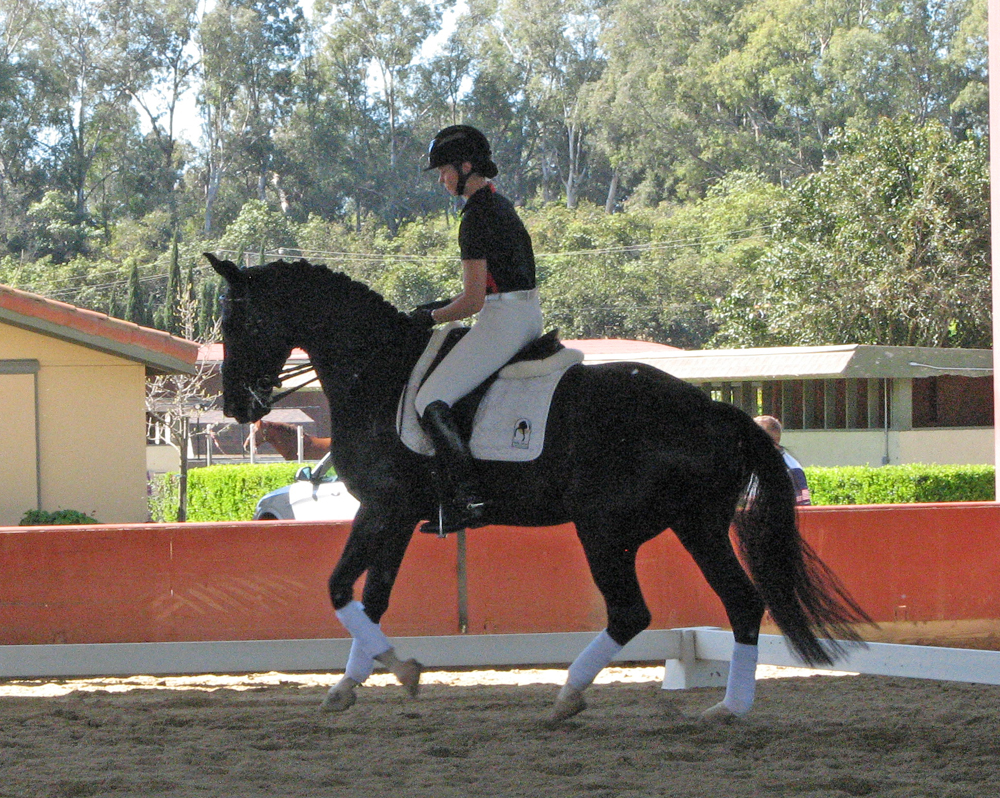
Sandy Savage and Releve’. Photo by Patti Schofler
While her sitting ability was clear in the test, it was the piaffe that brought out the smiles. As a movement, “The piaffe is about reaction,” Clarke said when she started. And as she continued, “Good grief. She is so honest. She really does react in the first stride. The way you have asked for piaffe work, she doesn’t know it is supposed to be hard. That’s because of the genuine reactions you have ridden into her.”
While praising her transition in and out of extensions, he made improvements in transitions to movements. “Use shoulder-fore positioning going in and coming out of the pirouette. Then the horse never learns to come out of the pirouette,” Clarke said.
He also warned not to stay too long in the pirouette canter. “It’s very hard for a horse. Do little and often; that’s what develops strength.”
Another exercise Savage demonstrated was shoulder-in on the rail, half-pass to centerline to shoulder-in. “Most people sit correctly in shoulder-in, but some sit to the outside in the half-pass. This helps to teach riders to sit in the center in half-pass,” Clarke noted.
This exercise was also useful for D’Re Stergios of Petaluma, Calif., and the Hanoverian Sarumba, a mare Clarke had “fallen in love with last year.”
ADVERTISEMENT
The first day the pair worked on relaxation as they rode a Prix St. Georges test for Clarke, Fore and the audience. “We see energy and activity of the hind leg joints. Very athletic. But in the test, though the paces are fantastic, the mare loses balance and regularity,” Clarke instructed. “Tension in the rider transmits to the horse. Confidence and security is the issue.”
Clarke warned that the tension can cause the rider to pull back with the reins when asking the horse to go forward, rather than leaving the contact still with a forward feel. Instead, the rider should control the forward movement as she creates more activity from the hind leg. “For that you need experience and confidence enough to leave the horse alone. You have the reaction and then you let go,” he said.
The pair performed exercises to improve reaction including walk to canter, a transition for which riders often over-prepare. “Personally, I would surprise her a little. Just go. Otherwise, she is wondering, ‘Are you sure?’ ” Clarke recommended.
In the second day, Clarke described Sarumba’s rhythm and regularity as spot-on. “Yesterday the energy did not know where to go,” he said.
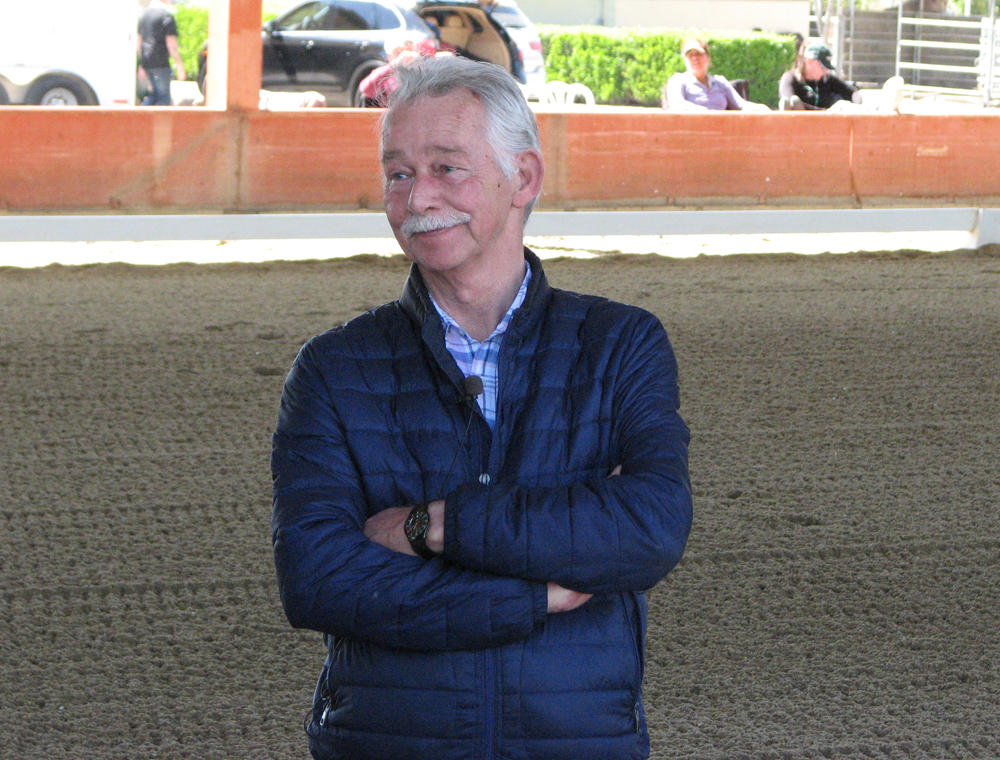
FEI Judge General Stephen Clarke shared his wisdom with the demonstration riders and the auditors. Photo by Patti Schofler
Charlotte Bredahl-Baker of Solvang, Calif., made huge progress with her supple Danish gelding Hamilton, who tended to swing through his tempi changes as she performed an Intermediaire I test. Rider and judge agreed that the horse had many different trots, also because of his suppleness.
In scoring the test, Clarke had to come down a bit on the rider score. “The rider is a very good rider, but she has to be able to manipulate the horse as she wants. I have huge respect for Charlotte, but the rider’s score reflects what they can show today in that test,” he said.
In the tempi changes, Clarke was not concerned about the flying changes themselves. “He has it in his mind to do the hula-hula on the diagonal. Forget the count. Take his mind off the number of changes and put it on going forward and submission,” he advised.
In keeping with Clarke’s focus on the quality of the horse’s reaction to aids, on Day 2, the session focused on Hamilton’s passage. Clarke had Bredahl-Baker really ride out of the passage. “The faster he goes out of it, the better he will go into passage the next time.”
As Sabine Schut-Kery of Thousand Oaks, Calif., warmed up in a posting trot on Pan American team Hanoverian Sanceo, Clarke, having judged the horse before, said, “Very nice of you to bring your beautiful horse, one of the most elegant horses I’ve seen.”
Schut-Kery’s rides on Sanceo on Day 1 and the next day on Marquese skillfully demonstrated Fore’s point that the horse must be adjustable in the frame, paces, tempo and movements. She played with “gear changes,” easily going from collection to extension and back, as well as collecting before a movement, and then thinking forward in the movement, as instructed by Clarke.
Within a half-pass, on the same line of travel, she could make the steps more ground covering and active and then more collected. In canter pirouettes, Sanceo was clearly adjustable by the rider, going from slower to faster tempo, from smaller to bigger to smaller, all relaxed, balanced, maintaining the rhythm. “It doesn’t get better than that,” Clarke said.
After a studied and careful warm-up, Clarke asked her, “Will you soon be ready for the test?”
“Only if you make me,” replied Schut-Kery.
“If I wait for you, it will be Christmas,” Clarke teased back.
ADVERTISEMENT
A spectator asked about the horse warming up behind the vertical. “You can only put a horse up if there are no limits to its throughness and suppleness,” Clarke said. “This is very different than some of the horrors we’ve seen. If she could not bring him up, I would eat my hat.”
After they did the test, Clarke said, “The future is very exciting. I know you are a perfectionist, but I would be happy with that test. Your riding is as good as anyone around including medalists.”
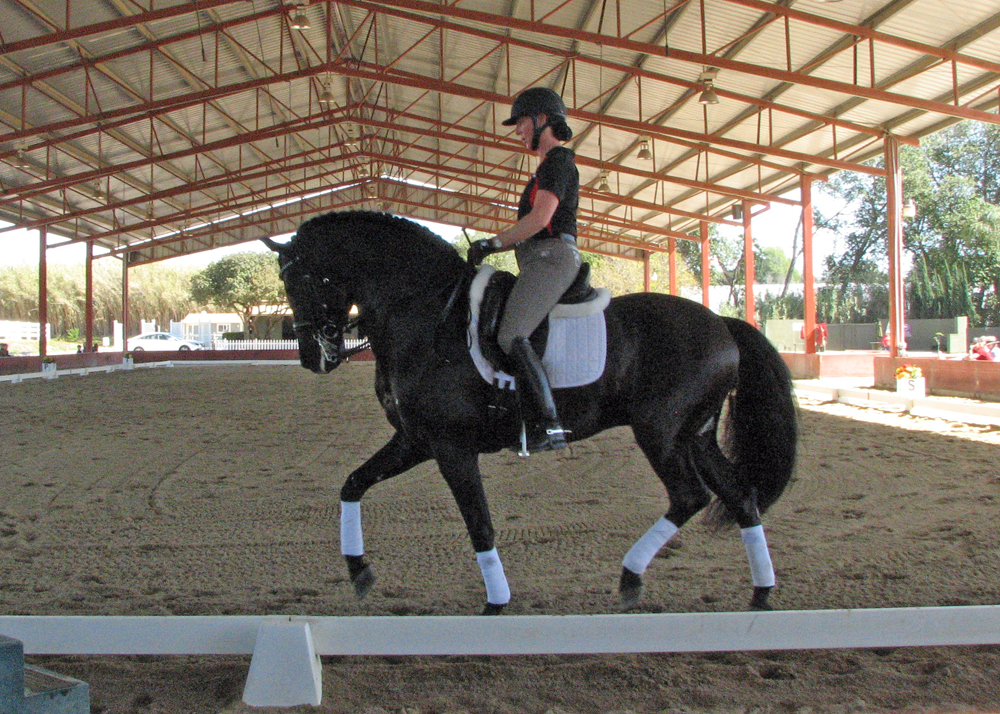
Sabine Schut-Kery on Marques. Photo by Patti Schofler
Clarke was asked how low to score with a mistake in a movement as in, for example, one of Schut-Kery’s canter pirouettes. “It’s about quality first. And being fair. One person could have a 5 for the same movement and another a 4. The 5 was already going for a higher score when the mistake happened.”
“If you gave a 4, you are only judging the mistake,” Fore added.
More questions arose regarding the correct posture of the horse when Jan Ebeling rode in on his Grand Prix stallion Rassolini. Being a stallion with a large crested neck, it is impossible for him to appear as though his poll is the highest point, the definition of the correct carriage.
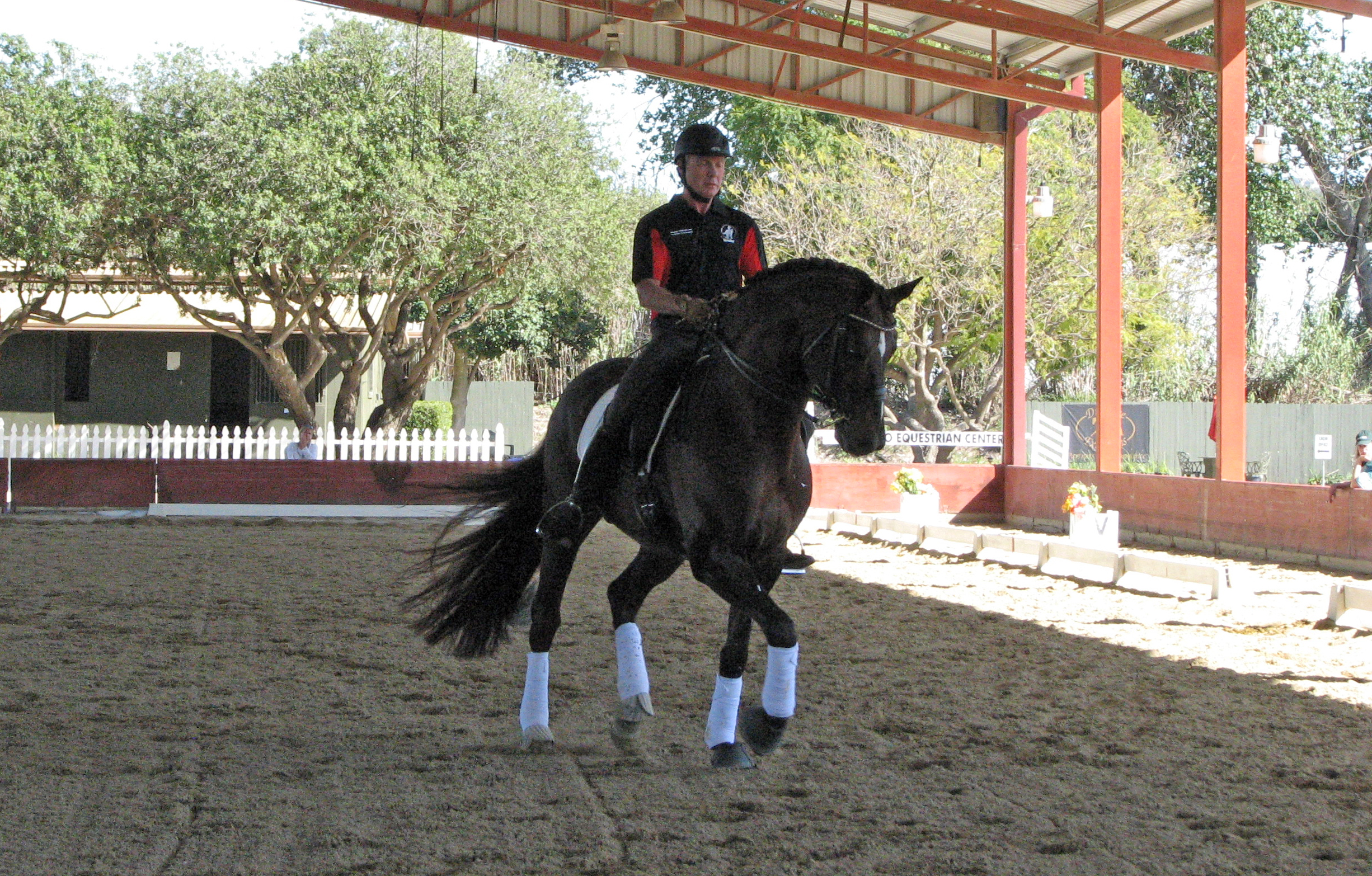
Jan Ebeling on Rassolini. Photo by Patti Schofler
“I look to see if the nose is behind the vertical to see if he is collapsing,” said Fore.
Clarke backed her up. “If we don’t recognize that, we’re not really horsemen,” he said.
As the discussion continued, Fore made the point that the contact should be soft, not empty. “Lightness is weight. We want something in our hands or else we can’t build the bridge that connects the two pillars,” the two ends of the horse, she noted.
Ebeling joined in. “Frame is controversial. Every horse is different, and you ride to their individual athleticism, conformation and gaits. But if the horse is too deep and behind the vertical, I think it’s impossible to get the back swinging and show off the gaits,” he said.
Two days prior to the conference, Ebeling had shown the stallion before Clarke, who recalled that the horse performed beautiful piaffe steps around the arena before starting the Grand Prix. Then, in the test, the stallion said “no” to piaffe. So they made a plan.
In riding the Grand Prix test at the conference, Ebeling took the time to reprimand the stallion when he did not respond on the first request for piaffe. Later in the test, the horse quit at X on the centerline where he was supposed to piaffe. Instead of continuing on, Ebeling did a half circle, turned down again the centerline and asked. This time he got that beautiful one Clarke had seen before.
“When he doesn’t react right away, Jan can’t choose the rhythm and how much to travel. The first step, no compromise. If you compromise in a half-halt when the reaction is not enough, you pay for it in the next five or six half-halts,” Clarke said.
And so Clarke’s message was clear from the Young Horse tests to the Grand Prix—reaction wins competitions.
Read all about Clarke and Fore’s work with three younger horses during the Adequan/USDF FEI-Level Trainers Conference West in “Future Stars Took Center Stage.”














